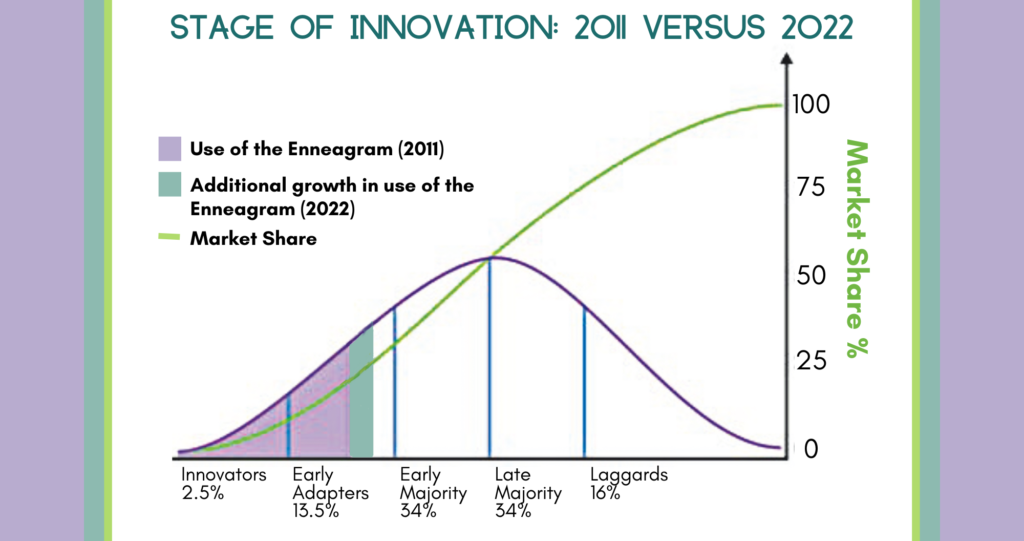The Enneagram in Business Network conducted two different research projects on the Enneagram’s use in organizations, one in 2011 and the other in 2022. As a subtext or underlying theme to each research project, one not asked directly but inferred, was this: What stage of innovation best describes the Enneagram’s use? Why this matters is that the Enneagram’s stage predicts what is likely to occur in the future. This model, Diffusion of Innovations, was developed in 1962 by Everett M. Rogers and illustrates the life cycle of an innovation over time, the percentage of companies at each stage as well as their characteristics, and the impact of being at each stage in terms of increasing market share.
Innovators (2.5%)
Innovators are organizations that are forward-looking risk-takers who employ innovative
approaches without needing the reassurance of others.
Early Adopters (13.5%)
Early adopters ask “who else is doing this” and take the risk once companies they admire have done it first.
Early Majority (34%)
Early majority includes organizations that don’t want to be left behind.
Late Majority (34%)
Late majority organizations do something only after it has been tried and proven
Laggards (16%)
Laggards are organizations that may never come on board.
To utilize innovation to increase market share, organizations need to be among the first 50% of adopters (by early majority).
In 2011, The Enneagram in Business Network conducted a Benchmark Study of best practices in using the Enneagram in organizations. What were we looking for, and why did we do this? Essentially, many of us in the network were being asked two things by prospective clients: (1) names of other organizations who were already using the Enneagram successfully, and (2) could we put these new clients in direct contact with our existing clients? These are early adopter questions, as can be seen above. The problem was that we could not give out client names without their permission, and our existing clients were too busy to talk with people from other companies. As a result, we did the 2011 Benchmark Report in which major companies are named (with their full permission), and we uncovered all the “how-tos” of best practices our prospective clients were seeking. We were a manifestation of the earlier stages of early adopter needs.
Fast forward to 2022, the Enneagram is still at the early adopter stage but has moved forward on the curve. Clients no longer ask who else is using the Enneagram because they often already know (or they no longer care). They want to know the array of benefits of using the Enneagram. And that is why The Enneagram in Business Network undertook the second research study to find out what were the key benefits of using the Enneagram in organizations. This question is also an early adopter query, although a middle point on the early adopter scale.
What’s Next
If Rogers’ model is correct and applies to the Enneagram‘s use in organizations, then what might be next? First, it might take five-to-ten years or more to reach the first phase of Early Majority. In 2011, the Enneagram had been used in organizations at least since the 1970s. Perhaps it has taken 40 years for the Enneagram to reach the Early Adopter stage. The pace seems to be going faster the more it is known and used. What will be the focus of the next research study on the Enneagram’s use in organizations? Will it be ROI (return on investment)? Will it be an organizational transformation?
Purpose of the 2001 study: Benchmark Report
The 2011 study was a benchmark study to research the most commonly used Enneagram applications, best practices in bringing the Enneagram into organizations, and what results were occurring. The methodology consisted of individual interviews with both organizational consultants and leaders with the criteria that the organization had been using the Enneagram for a minimum of 18 months. The results from the 72 companies studied were evaluated using a data content analysis, and the report methodology is considered qualitative research.
Purpose of the 2022 study: Online Enneagram in Organizations Global Survey Report
The focus of this research was primarily on the benefits or value of using the Enneagram in organizations but also asked questions about the most used Enneagram applications and how people want to learn more about the Enneagram in the future. The survey methodology was quantitative where survey takers selected answers from lists on the survey itself, although they could also opt to write in answers if they chose. 796 people from over 49 countries took the survey, and the trends were clear after the first 200 responders and never changed
Both studies were conducted by The Enneagram in Business Network, a network of over 70 professionals worldwide committed to the ethical use and spread of the Enneagram across the globe. To read the 2011 Benchmark Report, go here and scroll down the page. To read the 2022 Enneagram in Global Organizations Survey Report, go to enneagramsurvey.net. Both reports are available in multiple languages.
Ginger Lapid-Bogda PhD, author of nine Enneagram books, is a speaker, consultant, trainer, and coach. She provides certification programs and training tools for business professionals around the world who want to bring the Enneagram into organizations with high-impact business applications. TheEnneagramInBusiness.com | ginger@theenneagraminbusiness.com


Comments are closed.